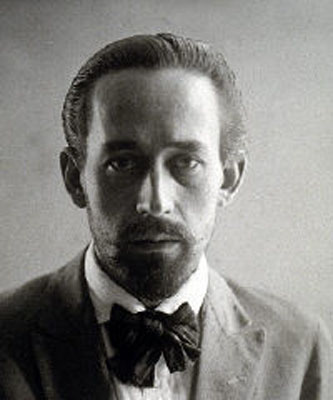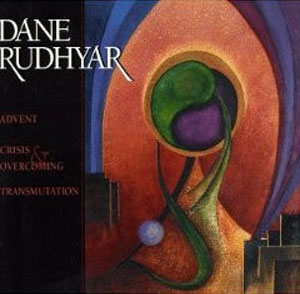DANE RUDHYAR

Metaphysical Ultramodernism
Part 1 by Daniel Barbiero
(June 2023)
Among the ultramodern composers--the New York-based group that in the 1920s arguably constituted America's first genuine musical avant-garde--Dane Rudhyar is one of the lesser known. There are several reasons for this, chief among them his having spent a number of decades as a professional astrologer. And, the fundamental principle underlying his compositional practice, which he called "dissonant harmony," set him apart from his ultramodern colleagues' better-known dissonant counterpoint. What also set him apart was his tendency to expound his musical theories in metaphysical, rather than technical, terms- as a theorist as well as a composer, he had developed a unique approach to composing post-tonal music based as much on the esoteric philosophies that attracted him all his life as on purely musical considerations. When all of these factors are put together, it isn't difficult to see why his music may have gone into eclipse. But his dissonant harmony remains interesting not only for the alternative it offered to the better known dissonant counterpoint, but for its having anticipated, in its own intuitive way, the spectralism of the later 20th century.
From Paris to America
Rudhyar was born Daniel Chennevière in Paris in 1895. His involvement with music began at age seven, when he started to play the piano. He began composing at the piano at age sixteen, after the death of his father, and took courses in music at the Paris Conservatory. Despite this early period of formal instruction, he was for the most part self-taught in composition. While still in his teens, he gravitated toward the avant-garde, attending concerts of Debussy's music in 1911 as well as the landmark 1913 premiere of Stravinsky's "Rite of Spring." Debussy was of particular importance to him at this time; in 1912 he wrote a book, unpublished and ultimately lost, on Debussy and the cycle of musical civilization, parts of which were incorporated into his booklet on Debussy, Claude Debussy et son oeuvre, which Durand published in 1913 along with three of Chennevière's short works for piano. His early creative work included collaboration with the dancer Valentine de Saint Point on a program of dance and music titled Métachorie, for which he wrote Four Symphonic Poems (also known as Metachoric Poems). The program seems to have been conceived of as a Scriabinesque multimedia presentation. In 1916, having been rejected for military service due to poor health--poor health is something that would plague him throughout his life--he went with Saint Point to New York to present Métachorie. Although a projected performance scheduled for that year fell through, the program was presented in April 1917 at the Metropolitan Opera, along with Chennevière's orchestral works Trois pöemes ironiques and Vision Végétale, both of which were composed in 1914. Unfortunately, the program appears not to have been well-received. Nonetheless, Chennevière remained in North America, where he traveled within the United States and Canada, touring East Coast cities to give lectures and performances.
In 1918 Chennevière, still not permanently settled in any one place, stayed in Toronto with Siegfried Herz and his pianist wife Djane Lavoie-Herz, whom he met in autumn 1917 in New York. His time in Canada marked a significant turn for him. It was there, in Montreal, that he met the pianist Alfred Laliberté, an associate of Scriabin's who introduced him to the Russian composer's music. Scriabin's influence and example would leave a profound imprint on him. During this period Chennevière also was introduced to theosophy, a kind of proto-New Age pastiche of Neoplatonism, Buddhism, Hinduism, and an esoteric interpretation of Christianity, that in one form or another provided him with a fundamental outlook on life. He wasn't alone in that regard; although little more than a quaint relic now, theosophy played a significant, if not always fully appreciated, role in inspiring avant-garde tendencies in the arts, particularly in relation to early abstract painting and Modernist poetry. Its combination of esotericism and pacifistic, liberal utopianism held great appeal for progressive-mided intellectuals and artists in the early 20th century. For Chennevière in particular, it exerted a deep and long-lasting influence on both his composing and his musical theorizing, as well as on his extra-musical life. It was also in Canada that he changed his name to the quasi-Sanskrit Rudhyar, which he chose for its allusion to the god Rudra and the color red (which was of astrological significance for him) and because it was supposed to signify as well the ideas of dynamic action and the power released by electrical storms.
First Flourishing: The 1920's
The 1920s saw the first real flourishing of Rudhyar's composing. It also was a period during which his work was brought before the public on a fairly regular basis. Both of these developments were facilitated by the connections he had made with other avant-garde American composers. Although he settled in Southern California in 1920, he continued his frequent travels and spent much time in New York where, crucially, he became associated with the ultramodern composers who were based there. These included Henry Cowell, whom he met in California in 1920 or 1921, at a theosophical convention; Charles Seeger; Carl Ruggles; Ruth Crawford, to whom he was introduced at the Herz's Chicago salon in 1925; and Carlos Salgado and Edgard Varèse, both of whom he had met in New York in 1917. During the decade he composed a good deal of what would eventually constitute his complete body of music. Sources differ on the dates and titles of his works, possibly because of his habit of revisiting, revising, and retitling compositions over time; following the listing in Deniz Ertan's essential study of Rudhyar's life and music, we can see that his work of the 1920s included the piano pieces Syntony (1919-1934); Tetragrams 1-8 (1920-1929); Moments and The Human Way (1924-1926; revised in the 1970's and combined and retitled Pentagrams); and Three Paeans (1925-1927). He also composed the orchestral works The Warrior (1921); Sinfonietta (1928); Soul Fire (1920); Syntony #1 (1919-1921); and Five Stanzas for String Orchestra (1926). As Slonimsky et al. have noted, most of his orchestral works were arrangements of pieces originally written for piano. Soul Fire was one of those. The piece is also notable for having won the Los Angeles Philharmonic's W. A. Clark Jr. prize in 1922, although the orchestra declined to perform it. As Rudhyar recalled during an oral history interview many years later, the piece wasn't played "because it was too difficult, or too modern" (CV, p. 129). A reworked version of the first movement was eventually realized in Paris in 1932 as From the Unreal Lead Us to the Real under the conductor Nicolas Slonimsky.
During the 1920's many of Rudhyar's works were performed under the auspices of groups that were being formed for the purpose of presenting new music. One of these groups was the International Composers' Guild (ICG), an organization founded by Varèse and Salzado in 1921 and of which Rudhyar was an early member. The ICG put on six seasons of concert programs at which new music by American and European composers was presented; Rudhyar's piano works Luciferian Stanza and Ravissement were on the 17 December 1922 program, while excerpts from his Moments were on the 27 December 1925 program. Rudhyar performed these pieces on piano himself. Outside of the ICG, his Three Paeans were performed by pianist Richard Buhlig at the Copland-Sessions concert of 6 May 1928; in 1930, Rudhyar performed his piano works Granites and Sonatina on programs for the League of Composers and Pro Musica respectively. He also had two pieces presented by the Pan American Association of Composers in 1930 and 1931: Moments for piano, played by Imre Weisshaus, and The Surge of Fire for chamber orchestra.
The 1930s and the Turn to Astrology
If the 1920's were for Rudhyar a time of intense involvement with music, the following decade brought a change of direction. It was then that he turned his attention largely to astrology. This turn represented less of a radical reorientation than a shift in focus: underlying both his music and his work in astrology were the larger concerns that animated his interest in theosophy and in esotericism in general. Music and astrology were just two different channels through which he could express those concerns. As early as 1920, he had been introduced to astrology. While staying near the theosophical center in Krotona, California that year, he met a Mrs. Van Vliet who inspired him to study astrology, which he did for a brief time. In 1930, contact with the astrologer Marc Edmund Jones rekindled his interest. It was a time when, as he put it in an unpublished autobiography, he was looking for new "a frame of reference." In fact, the decade of the 1930's was a time of personal and health crises for him, which seem to have become particularly intense in 1932-1933, which he described as a "breaking point." Astrology gradually replaced music as his main focus, and he began to write regularly for American Astrology magazine. He would go on to publish a substantial number of articles and books on the subject in the coming decades, and it was as an astrologer, rather than an avant-garde composer, that he became best known.
Although astrology formed the crux of his professional life after 1933, he did not abandon music altogether. He continued to work on the Syntonies for piano through 1934, composed a cycle of songs in 1939, and gave at least one recital of piano music, at the Santa Fe Museum, in 1938. Periodically, public interest in his music would be revived and with it, his own activity as a composer. In 1948, some of his work was performed, and he composed Emergence for string orchestra. Over the course of the next few years he composed Triphtong for orchestra, and his Solitude for string quartet was performed. But after 1952, interest in his music waned once again, and he drifted away from composition until 1967, when he revised some of his earlier work.

The 1970's were a time of rediscovery and recognition as well as a final flourishing of creative work. By then, Rudhyar seems to have become something of a local guru figure. Vivian Perlis, who interviewed him in 1970, described him as having a "long beard and white robe" and being surrounded by "what seemed to be acolytes in beads in sandals." Some of them apparently were interested in his work outside of astrology. Writing to Perlis in 1972, he told her that "[t]he young people who now buy all my books are particularly responsive to my music" (CV, p. 128). As if to confirm his statement, in 1972, the radio station KPFA held a three week retrospective of his musical and extra-musical work, and pianist Michael Sellers recorded an album of his piano compositions. In 1976 he wrote the string quartet Advent for the Kronos Quartet and in 1979, the string quartet Crisis and Overcoming, both of which Kronos recorded for CRI. By the time he died in 1985, he had once again become known for his music.
Pianist, avant-garde composer, occultist and astrologer: Rudyhar was all of these. He would seem, in fact, to have been something like a Renaissance man of an alternative culture. And when we consider how much of a role occult ideas played in the thinking of the original Renaissance men, the designation doesn't seem all that far off. But beyond all that he was a theorist of music, and it is to the theorist that we will turn in the next part of this article.
See Part III of this article